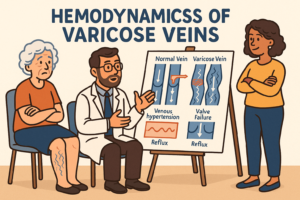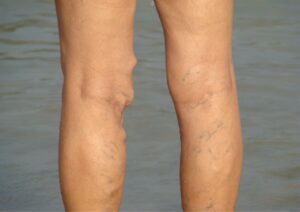Vein disease, also known as chronic venous insufficiency, is a common condition that affects millions of people worldwide. Chronic venous insufficiency occurs when the veins in your legs struggle to send blood back to your heart, leading to various symptoms and complications. Understanding the signs of chronic venous insufficiency can help you seek timely medical intervention and improve your vascular health. This blog will explore the key indicators of chronic venous insufficiency, its causes, risk factors, and available treatment options.
What is Vein Disease or Chronic Venous Insufficiency?
Vein disease, or chronic venous insufficiency (CVI), happens when the valves in your veins malfunction, causing blood to pool in the lower extremities. This pooling of blood can lead to the bursting of tiny blood vessels, resulting in skin discoloration and other complications. This can lead to swelling, pain, and other uncomfortable symptoms. If left untreated, chronic venous insufficiency can result in more severe conditions like deep vein thrombosis (DVT) or venous ulcers.
Signs and Symptoms of Vein Disease
Identifying the early signs and symptoms of chronic venous insufficiency is crucial for preventing its progression. Common symptoms include:
Swollen Ankles and Legs: Persistent swelling, especially after long periods of standing or sitting, is a hallmark of vein disease.
Varicose Veins: Enlarged, twisted veins visible under the skin are often a sign of underlying venous insufficiency.
Leg Pain and Cramping: Aching, throbbing, or a heavy sensation in the legs, often accompanied by cramps, can indicate vein disease.
Skin Changes: Discoloration, itching, or the development of ulcers around the ankles can be signs of advanced vein disease.
Restless Legs: An urge to move your legs, particularly at night, can be associated with vein issues.
Spider Veins: Smaller, web-like veins that can appear on the legs and face, often resembling a spider’s web, are a common, mild form of varicose veins.
Blood Clots: Recognizing and managing blood clots is essential to prevent serious complications such as deep vein thrombosis (DVT) and pulmonary embolism. Seek medical attention if you suspect blood clots.
Causes and Risk Factors
Several factors can contribute to the development of chronic venous insufficiency:
Age: Aging can weaken vein walls and valves, increasing the risk of venous insufficiency. Aging can also increase the risk of blood clots forming in the deep veins.
Genetics: A family history of vein disease can predispose you to similar issues, leading to problems with leg veins.
Obesity: Excess weight puts additional pressure on your veins, making it harder for them to function properly. Obesity can also increase the risk of blood clots in the deep veins.
Prolonged Sitting or Standing: Occupations or lifestyles that involve long periods of inactivity can contribute to vein problems.
Pregnancy: Hormonal changes and increased blood volume during pregnancy can strain veins, leading to temporary or permanent vein issues.
Hormonal Changes: Hormones, especially in women, can affect vein health, making conditions like vein disease more likely.
Diagnosis and Treatment
If you suspect you have vein disease, it’s essential to consult a healthcare professional for a proper diagnosis. They may perform a physical examination, ultrasound, or other imaging tests to assess the condition of your veins. During the examination, the doctor will look for visible signs of vein issues, such as varicose veins, swelling, skin changes, and ulcers. They will also assess how blood flows through the veins to ensure proper circulation. To confirm the diagnosis and assess the severity of the condition, non-invasive imaging tests like Doppler ultrasound are commonly used. This test uses sound waves to visualise blood flow in the veins and identify areas of reflux or blockage. It can also help identify issues with superficial veins near the skin’s surface. In some cases, additional imaging techniques like venography may be employed for a more detailed view. Accurate diagnosis is essential for determining the appropriate treatment plan and managing the symptoms effectively, helping to prevent complications and improve overall vascular health.
Treatment options for vein disease include:
– Lifestyle Changes: Regular exercise, maintaining a healthy weight, and elevating your legs can help improve vein function.
– Compression Stockings: These special stockings apply pressure to your legs, promoting blood flow and reducing swelling.
– Medications: In some cases, medications may be prescribed to manage symptoms or prevent complications.
– Minimally Invasive Procedures: Treatments like sclerotherapy, laser therapy, or radiofrequency ablation can close off or remove problematic veins.
– Surgery: In severe cases, surgical intervention may be necessary to address vein issues.
Preventing Vein Disease
While some risk factors for vein disease are beyond your control, you can take steps to reduce your risk:
– Stay Active: Regular physical activity can improve circulation and strengthen your veins.
– Maintain a Healthy Weight: Reducing excess weight can alleviate pressure on your veins.
– Avoid Prolonged Inactivity: Take breaks to move around if you have a sedentary job or lifestyle.
– Elevate Your Legs: When resting, elevate your legs to promote blood flow back to your heart.
– Wear Compression Stockings: If you’re at risk, compression stockings can help prevent the development of vein disease.
Conclusion
Vein disease is a common but manageable condition. By recognizing the signs and symptoms early and seeking appropriate medical care, you can effectively manage your vein health and prevent complications. If you suspect you have vein disease, don’t hesitate to consult a healthcare professional to explore your treatment options and improve your quality of life. Remember, proactive care and lifestyle changes can make a significant difference in maintaining healthy veins.









